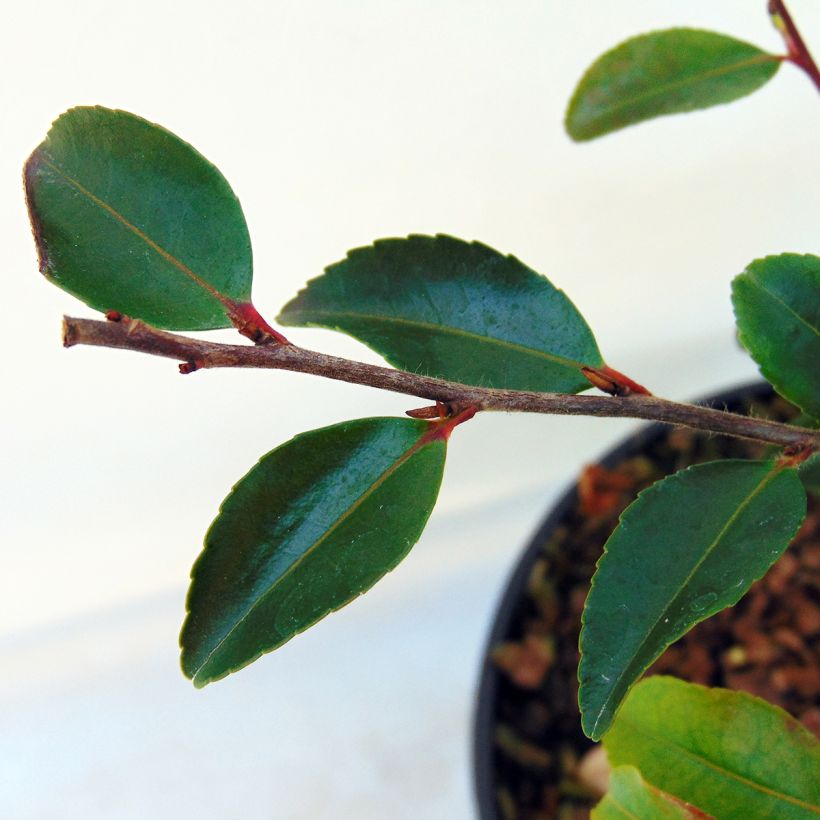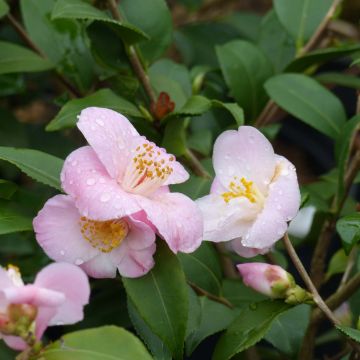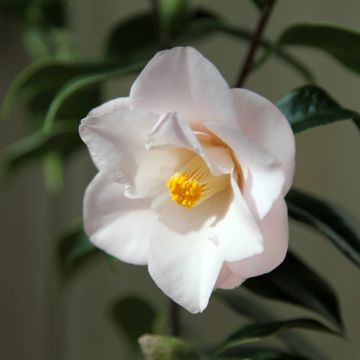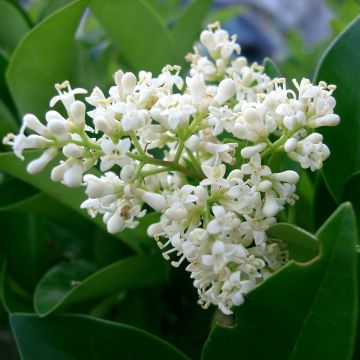

Camellia lutchuensis
Camellia lutchuensis
Camellia lutchuensis
As usual, it is a high-quality young plant, received promptly. There was an effort to securely package it and prevent any damage during transit.
Jean-Marc, 13/12/2020
Special offer!
Receive a €20 voucher for any order over €90 (excluding delivery costs, credit notes, and plastic-free options)!
1- Add your favorite plants to your cart.
2- Once you have reached €90, confirm your order (you can even choose the delivery date!).
3- As soon as your order is shipped, you will receive an email containing your voucher code, valid for 3 months (90 days).
Your voucher is unique and can only be used once, for any order with a minimum value of €20, excluding delivery costs.
Can be combined with other current offers, non-divisible and non-refundable.
Why not try an alternative variety in stock?
View all →This plant carries a 24 months recovery warranty
More information
We guarantee the quality of our plants for a full growing cycle, and will replace at our expense any plant that fails to recover under normal climatic and planting conditions.

Would this plant suit my garden?
Set up your Plantfit profile →
Description
Camellia lutchuensis is the most fragrant of wild camellias. With its tiny white spring flowers, its lovely rounded habit and its delicate foliage, it is very different from other camellias and will charm even those who criticise these bushes as being too stiff and artificial-looking. This botanical species, native to southern Japan, requires a moist, non-chalky soil and is resistant to moderate frosts, down to around -9°C for short periods of time. The bush, attractive even outside of the flowering season, will keep its lovely foliage throughout the year. Definitely worth a try, either on its own in the garden or on the terrace, in a pretty pot to store under cover in cold regions.
Camellia lutchuensis is a botanical species found in southeastern China, Taiwan, and the Ryukyu Islands, located southwest of Japan. In the wild, it forms a beautiful bush or a small tree measuring 4 to 7 metres (13 to 23 feet) in height, but it will remain much smaller in European climates. Like all camellias it belongs to the family Theaceae. The sweet fragrance of its flowers has led breeders to hybridise it with many other camellias.
This bush has a flexible, rounded, and branching habit and shows rapid growth for a camellia. It will reach an average of 1.2 m (4 ft) in all directions at maturity. Its blooms are abundant and remarkably fragrant, usually occurring in March-April. White flower buds with pink variegation open in large numbers. The solitary or clustered flowers can resemble those of the orange tree. Each one measures about 4 cm (1.6 in) in diameter and is composed of 5 rather triangular, pure white petals, sometimes slightly tinged with pink. The heart of white stamens covered with yellow pollen is clearly visible. The foliage is dense and evergreen, the small, thick, ovate leaves taper to a point and have finely toothed edges. They measure about 4 cm (1.6 in) long and 2 cm (0.8 in) wide. Their colour is slightly olive, fairly dark, and glossy green.
Camellia lutchuensis, like all camellias, thrives in mild and humid climates rather than in cold regions, where its hardiness may be insufficient and its flowering destroyed by late frosts. On the other hand, it does not appreciate dense shade and will tolerate sunny sites as long as they are not scorching. Where winters are relatively mild it can be planted in the garden as a solitary specimen or in combination with other acid-loving plants (Rhododendron, azaleas, Hydrangea, Hamamelis, Pieris) in a shrub bed. Its wild appearance and delicate flowering are marvelous in a natural or cottage garden, with a Chimonanthus praecox, for example. You can also adorn its base with spring bulbs (daffodils, tulips, wood hyacinths) or autumn bulbs such as colchicums or cyclamen. In cold regions it can be planted in a container on the balcony or terrace, to be brought indoors to a conservatory or cold greenhouse during flowering.
Report an error about the product description
Camellia lutchuensis in pictures




Plant habit
Flowering
Foliage
Botanical data
Camellia
lutchuensis
Theaceae
Southeast Asia
Other Camellias A to Z
View all →Planting and care
Camellia lutchuensis should be placed in a sunny or partially shaded position, preferably sheltered from cold and drying winds. If you do cultivate it in (non scorching) sun, the roots must always remain cool. Plant it in a soil that remains moist and is humus-rich, acidic, free from limestone, and well-drained. The shrub should not be planted too deeply; the top of the root ball should be covered with 3 cm (1.2 in) of soil. In winter cover it with a 5 to 7 cm (2 to 3 in) thick mulch composed of leaf soil and crushed bark. Beware of late frosts that can damage flowers and buds. Water during dry periods to prevent the dropping of flower buds. Pruning should be done every year after flowering. Lightly trim any stems that prevent the shrub from maintaining its compact appearance. Remove faded flowers if you do not want fruit and remove dead shoots. The mature Camellia can withstand hard pruning. Camellias can be susceptible to rot, leaf spots, and viruses. It can be attacked by aphids and scale insects that cause sooty mould, as well as by weevils.
Planting period
Intended location
Care
-
, onOrder confirmed
Reply from on Promesse de fleurs
Similar products
Haven't found what you were looking for?
Hardiness is the lowest winter temperature a plant can endure without suffering serious damage or even dying. However, hardiness is affected by location (a sheltered area, such as a patio), protection (winter cover) and soil type (hardiness is improved by well-drained soil).

Photo Sharing Terms & Conditions
In order to encourage gardeners to interact and share their experiences, Promesse de fleurs offers various media enabling content to be uploaded onto its Site - in particular via the ‘Photo sharing’ module.
The User agrees to refrain from:
- Posting any content that is illegal, prejudicial, insulting, racist, inciteful to hatred, revisionist, contrary to public decency, that infringes on privacy or on the privacy rights of third parties, in particular the publicity rights of persons and goods, intellectual property rights, or the right to privacy.
- Submitting content on behalf of a third party;
- Impersonate the identity of a third party and/or publish any personal information about a third party;
In general, the User undertakes to refrain from any unethical behaviour.
All Content (in particular text, comments, files, images, photos, videos, creative works, etc.), which may be subject to property or intellectual property rights, image or other private rights, shall remain the property of the User, subject to the limited rights granted by the terms of the licence granted by Promesse de fleurs as stated below. Users are at liberty to publish or not to publish such Content on the Site, notably via the ‘Photo Sharing’ facility, and accept that this Content shall be made public and freely accessible, notably on the Internet.
Users further acknowledge, undertake to have ,and guarantee that they hold all necessary rights and permissions to publish such material on the Site, in particular with regard to the legislation in force pertaining to any privacy, property, intellectual property, image, or contractual rights, or rights of any other nature. By publishing such Content on the Site, Users acknowledge accepting full liability as publishers of the Content within the meaning of the law, and grant Promesse de fleurs, free of charge, an inclusive, worldwide licence for the said Content for the entire duration of its publication, including all reproduction, representation, up/downloading, displaying, performing, transmission, and storage rights.
Users also grant permission for their name to be linked to the Content and accept that this link may not always be made available.
By engaging in posting material, Users consent to their Content becoming automatically accessible on the Internet, in particular on other sites and/or blogs and/or web pages of the Promesse de fleurs site, including in particular social pages and the Promesse de fleurs catalogue.
Users may secure the removal of entrusted content free of charge by issuing a simple request via our contact form.
The flowering period indicated on our website applies to countries and regions located in USDA zone 8 (France, the United Kingdom, Ireland, the Netherlands, etc.)
It will vary according to where you live:
- In zones 9 to 10 (Italy, Spain, Greece, etc.), flowering will occur about 2 to 4 weeks earlier.
- In zones 6 to 7 (Germany, Poland, Slovenia, and lower mountainous regions), flowering will be delayed by 2 to 3 weeks.
- In zone 5 (Central Europe, Scandinavia), blooming will be delayed by 3 to 5 weeks.
In temperate climates, pruning of spring-flowering shrubs (forsythia, spireas, etc.) should be done just after flowering.
Pruning of summer-flowering shrubs (Indian Lilac, Perovskia, etc.) can be done in winter or spring.
In cold regions as well as with frost-sensitive plants, avoid pruning too early when severe frosts may still occur.
The planting period indicated on our website applies to countries and regions located in USDA zone 8 (France, United Kingdom, Ireland, Netherlands).
It will vary according to where you live:
- In Mediterranean zones (Marseille, Madrid, Milan, etc.), autumn and winter are the best planting periods.
- In continental zones (Strasbourg, Munich, Vienna, etc.), delay planting by 2 to 3 weeks in spring and bring it forward by 2 to 4 weeks in autumn.
- In mountainous regions (the Alps, Pyrenees, Carpathians, etc.), it is best to plant in late spring (May-June) or late summer (August-September).
The harvesting period indicated on our website applies to countries and regions in USDA zone 8 (France, England, Ireland, the Netherlands).
In colder areas (Scandinavia, Poland, Austria...) fruit and vegetable harvests are likely to be delayed by 3-4 weeks.
In warmer areas (Italy, Spain, Greece, etc.), harvesting will probably take place earlier, depending on weather conditions.
The sowing periods indicated on our website apply to countries and regions within USDA Zone 8 (France, UK, Ireland, Netherlands).
In colder areas (Scandinavia, Poland, Austria...), delay any outdoor sowing by 3-4 weeks, or sow under glass.
In warmer climes (Italy, Spain, Greece, etc.), bring outdoor sowing forward by a few weeks.


























































